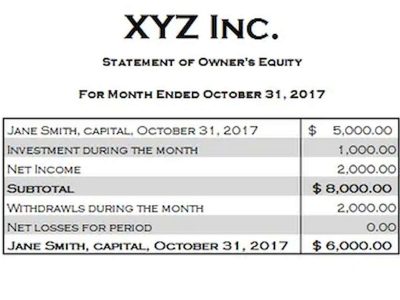
The general format of the investing activities section is illustrated below. It is just an illustration, not a complete list of all cash inflows and outflows that may result from the investing activities of a company. Accounting for Technology Companies A cash flow statement is a regular financial statement telling you how much cash you have on hand for a specific period. Cash flow from assets shows the cash flow of a company’s different types of assets.
- Keep in mind, positive cash flow isn’t always a good thing in the long term.
- The interest earned on loans and advances is reported in the statement of cash flows as described above.
- Bench simplifies your small business accounting by combining intuitive software that automates the busywork with real, professional human support.
- For that reason, smaller businesses typically prefer the indirect method.
- Securing favorable credit terms as a buyer can help you keep cash on-hand for longer.
- On the other hand, consistent dividends and stock buybacks signal financial strength and a commitment to shareholder value.
How to Calculate Cash Flow from Assets
- Cash Flow for Month Ending July 31, 2019 is $500, once we crunch all the numbers.
- If you run a pizza shop, it’s the cash you spend on ingredients and labor, and the cash you earn from selling pies.
- And during the accounting period, we charged a $50,000 depreciation expense to the income statement and we also had a $10,000 gains on the disposal of fixed assets transaction during the period.
- Find out how GoCardless can help you with one-off or recurring payments.
Cash Flow From Assets refers to the accounting measure that assesses the money derived from or consumed in the business’s operating and investing activities performed by utilizing the company’s assets. However, it doesn’t consider the cash flow from financing activities such as issuance of stocks or buyback. Depreciation itself is a non-cash expense, meaning no cash is actually paid out when depreciation is recorded in the income statement. When analyzing the cash flow from operating activities, particularly under the indirect method, we start with net income and adjust for changes in working capital and non-cash expenses. This figure represents the cash generated by the company’s day-to-day operations. It can typically be found in a company’s financial statement under operating activities.

How to generate more cash flow from assets
Together with other figures on the cash flow statement, cash flow from assets is a helpful metric used in accounting. It gives a snapshot of your business’s financial health, showing how much your business needs to spend on operational basics. Investors will be interested in viewing cash flow from assets to see where your business spends its money and how much is left over. Cash flow from investing (CFI) or investing cash flow reports how much cash has been generated or spent from various investment-related activities in a specific period. Investing activities include purchases of speculative assets, investments in securities, or sales of securities or assets. To begin with, let’s take a closer look at the cash flow from assets statement.

What is net capital spending, and how does it affect cash flow from assets?
So, even if you see income reported on your income statement, you may not have the cash from that income on hand. The cash flow statement makes adjustments to the information recorded on your income statement, so you see your net cash flow—the precise amount of cash you have on hand for that time period. cash flow from assets formula As mentioned, when preparing the cash flow statement, we need to remove these gains and losses from the net income that we get from the income statement. In this case, we need to deduct the gain amount while the loss amount will need to be added back. It’s normal for companies to sometimes face negative cash flow from assets, which is bad for the company. It is calculated by including net income which is obtained by deducting business costs from revenue.
This way, companies can segregate various cash transactions based on the areas to which they relate. Cash flow from assets (often abbreviated as “CFFA”) refers to the total cash flow generated by a company’s assets, not taking into account cash flow from financing activities. It measures a company’s ability to generate cash inflows from its core operations using strictly its current assets and fixed assets.

Offers Insights into a Business’s Liquidity
It fails to consider other factors such as debt, market conditions, and future investments, providing an incomplete picture of overall financial stability. By performing this calculation regularly and comparing results over time, you can gain valuable insights into your business’s financial health and identify areas for improvement. It will help you understand whether your day-to-day operations are generating enough cash to sustain and grow your business. To calculate net cash, start with your net income and add back any non-cash expenses such as depreciation or amortization. Next, consider changes in working capital, including accounts receivable, inventory, and accounts payable. If there are increases in these items, subtract them from net income; if there are decreases, add them to net income.
Episode 170: The Illusion of Understanding and the Study Success Cycle
- But it still needs to be reconciled, since it affects your working capital.
- Usually, companies acquire fixed assets that contribute to their operations.
- However Many types of assets are available in a firm, but mainly those three are most important.
- To analyze your cash flow from assets, you will need to review your financial statements.
- In this article, we will walk you through the purpose of the Cash Flow from Assets Calculator, explain how to use it, provide a real-world example, and offer helpful insights into its benefits.
- The resulting figure is your net capital spending (NCS), which indicates the net cash used for or received from investments in the company’s long-term assets.
- By examining each component of the statement, you can identify any areas where improvements can be made or potential risks may arise.
Accelerating the collection of accounts receivables through early payment discounts and proactive credit policies can expedite cash inflows. Additionally, monitoring inventory levels and implementing just-in-time inventory systems can reduce holding costs and optimize cash utilization. Management makes informed decisions about investments, divestitures, or replacements by assessing which assets yield strong cash flows and which don’t.
Cash Flow Statement
Under Cash Flow from Investing Activities, we reverse those investments, removing the cash on hand. They have cash value, but they aren’t the same as cash—and the only asset we’re interested online bookkeeping in, in this context, is currency. But here’s what you need to know to get a rough idea of what this cash flow statement is doing. In our examples below, we’ll use the indirect method of calculating cash flow. Since it’s simpler than the direct method, many small businesses prefer this approach. Also, when using the indirect method, you do not have to go back and reconcile your statements with the direct method.
Understanding Cash Flow Statements

Remember that analyzing your cash flow from assets is not just about identifying weaknesses but also recognizing opportunities for growth. By staying vigilant and regularly reviewing these patterns, you can ensure that your business remains financially healthy and poised for success in an ever-changing market environment. Calculating CFFA involves factors including operating cash flow (OCF), net capital spending (NCS), and changes in net working capital (ΔNWC). Even small missteps, such as skipping an adjustment for depreciation or misclassifying a cash flow, can lead to inaccurate results.

Recent Comments